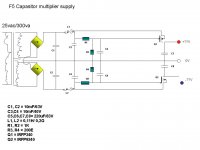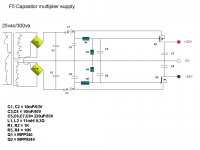add resistors in parallel to C5 and C6.
The ratio of R1 & extra R determines what voltage drop you get across the transistor.
Aim for a ratio of 1:10 to 1:20
The ratio of R1 & extra R determines what voltage drop you get across the transistor.
Aim for a ratio of 1:10 to 1:20
Hi,
Figure 6 in
http://passdiy.com/pdf/zen-ver3.pdf
shows a regulated power supply. If you remove the zener diodes (Z1-Z6)
then you have a cap multiplier.
Figure 6 in
http://passdiy.com/pdf/zen-ver3.pdf
shows a regulated power supply. If you remove the zener diodes (Z1-Z6)
then you have a cap multiplier.
The cap mult droping out 4v Zen Mod is speaking about (each rail needs one) is in Zen V9.
Not to forget the added dissipation.
Not to forget the added dissipation.
nope - use mosfet instead of bjt ;
as I said - you'll loose 4V
Whether bipolar or MOSFET, the devices have to be heatsinked since you're burning off, at idle, 1.3 amps per volt dissipated.
Might just be better to cascode the JFETs since the MOSFETs can take the higher voltage.
I think you're better off with the right transformer. Did you draw that diagram with an Etch-A-Sketch?
Did you draw that diagram with an Etch-A-Sketch?
I use Powerpoint.
you have the ratio back to front.
I said 1:10 to 1:20
You have shown 1:0.2
Change the 200r to 10k or 20k or somewhere in between.
L1 & L2 = 110mH !!!!
I said 1:10 to 1:20
You have shown 1:0.2
Change the 200r to 10k or 20k or somewhere in between.
L1 & L2 = 110mH !!!!
Last edited:
you have the ratio back to front.
L1 & L2 = 110mH !!!!
11mH🙂. How much rippel current do C5 - C8 need to handle. I think the ones I have are about 0.5A.
Attachments
great news 🙂!
i hope all reference or at least the most popular projects will be listed here.
1. REFERENCE DAC --- ESS SABRE BASED?
2. PREAMP + ACTIVE XO --- B5? if Mr. PASS gives the approval
3. F3, F5
cheers
henry
i hope all reference or at least the most popular projects will be listed here.
1. REFERENCE DAC --- ESS SABRE BASED?
2. PREAMP + ACTIVE XO --- B5? if Mr. PASS gives the approval
3. F3, F5
cheers
henry
I threw in the towel for a 4xMOSFET F5. I ran it for about a week without issues and then I went to put it in my main system and upon firing it up I blew another 2sk170...ARRRGH!
So, went back to the original design and biased it up to 1.8A per FET...Seems that the drive is a little less but still very nice.
I may have to get my hands on a pair of CVILLERs boards someday...
So, went back to the original design and biased it up to 1.8A per FET...Seems that the drive is a little less but still very nice.
I may have to get my hands on a pair of CVILLERs boards someday...
CJ......,
If I may ask, why did you bias so high? Are you like me? one of the unlucky few who have 89dB or less speakers? Or do you simply prefer the sound of it biased that high?
Ron
If I may ask, why did you bias so high? Are you like me? one of the unlucky few who have 89dB or less speakers? Or do you simply prefer the sound of it biased that high?
Ron
The diyAudio Store is operating well.. F-5 orders being taken and shipped - a miracle!
Will revision 2 be made available also?
I am more interested in revision 2.
> The cap mult droping out 4v Zen Mod is speaking about (each rail needs one) is in Zen V9.
This is only true if you use IRFP MOsfets, the Vgs of which at the operating current is about 4V.
(And it is dropout per rail.)
There are other FETs with lower Vgs at the same current. Using Fairchild FETs FQP..... will drop a bit over 3V, using Semisouth JFETs hardly anything, using Toshiba 2SK1530-Y about 2.2V, and Toshiba 2SK1530-O (about 1.2V, if you can find them) even less.
So 4V is not holy number. (Sorry choky, I cannot resist.)
Patrick
PS I should add that the min. dropout voltage has to be larger than the ripple voltage at operating current, which depends on the size of the C's before the Cap Multiplier. Or else the regulator cannot regulate properly, as it can only regulate by dropping voltage.
.
This is only true if you use IRFP MOsfets, the Vgs of which at the operating current is about 4V.
(And it is dropout per rail.)
There are other FETs with lower Vgs at the same current. Using Fairchild FETs FQP..... will drop a bit over 3V, using Semisouth JFETs hardly anything, using Toshiba 2SK1530-Y about 2.2V, and Toshiba 2SK1530-O (about 1.2V, if you can find them) even less.
So 4V is not holy number. (Sorry choky, I cannot resist.)
Patrick
PS I should add that the min. dropout voltage has to be larger than the ripple voltage at operating current, which depends on the size of the C's before the Cap Multiplier. Or else the regulator cannot regulate properly, as it can only regulate by dropping voltage.
.
Last edited:
... and with the Cmultipliers, the + & - rails don't come up to voltage at same rate, (with the IRFP devices, anyway) so need o/p delay Rx to avoid dc on speakers.
> and with the Cmultipliers, the + & - rails don't come up to voltage at same rate,
If that is true then your R-C-R-C filter for the MOSFET gates are not slow enough (I normally design for 1~2 seconds) and the values are not matched, or the caps after the MOSFETs are also not matched. The transistors are quick enough and the small difference in speed will be dominated by those R-C's.
Patrick
If that is true then your R-C-R-C filter for the MOSFET gates are not slow enough (I normally design for 1~2 seconds) and the values are not matched, or the caps after the MOSFETs are also not matched. The transistors are quick enough and the small difference in speed will be dominated by those R-C's.
Patrick
Last edited:
Ah, right - got concerned with the DAO and took the safe approach here, too - want the freedom to alter the caps for sound - more homework required!
- Home
- Amplifiers
- Pass Labs
- F5 power amplifier

